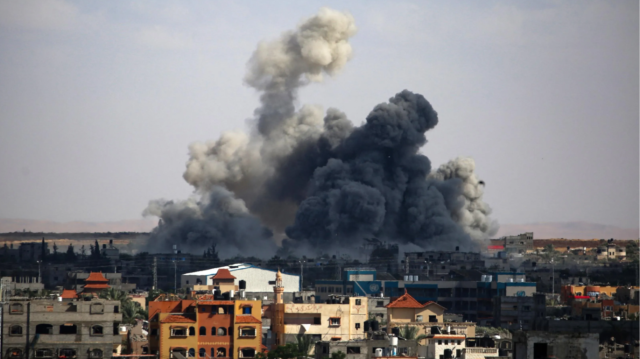The Daunting Challenge of Debris and Unexploded Ordnance in Gaza
The remnants of conflict in Gaza pose a serious threat, with an estimated 37 million tonnes of debris taking up to 14 years to clear, raising humanitarian and environmental concerns.
Published April 28, 2024 - 00:04am

Image recovered from tvanouvelles.ca
After the most recent Israeli offensive in Gaza, the United Nations Mine Action Service (UNMAS) has reported that there are approximately 37 million tonnes of debris to clear, a figure that underlines the sheer scale of destruction left behind. The daunting task of removing this rubble, which equates to around 300 kilograms per square meter, could take an estimated 14 years, even with a fleet of 100 trucks working continuously.
Complicating the already monumental challenge is the presence of unexploded ordnance (UXO) among the ruins, adding a dangerous layer to clearance efforts. UXOs pose a perennial risk to civilians, demining teams, and anyone involved in the reconstruction efforts. UNMAS official Pehr Lodhammar, who has experience with similar situations in Iraq albeit on a smaller scale, estimated a standard failure rate where at least 10 percent of land service ammunition does not detonate as intended.
These alarming statistics not only represent a technical and logistical nightmare but also signify an ongoing threat to the safety and well-being of Gaza's residents. The situation is especially critical considering that the majority of the destroyed structures were residential. The repeated cycle of violence and the subsequent clean-up reflects a pattern that, if unbroken, risks perpetuating instability and suffering in the region. Humanitarian groups, including the secretary-general of the Norwegian Refugee Council, Jan Egeland, have expressed deep concern over the potential for escalating conflict and the catastrophic implications for civilians not just in Gaza, but across the Middle East.
Amidst the rubble and despair, efforts to address the UXO threat are underway. The United Nations Development Programme (UNDP) and non-governmental organizations have convened in Amman to seek the best approaches for managing the debris that is intermingled with explosives. Initiatives launched will not only involve clearance but also preparation for what might lay ahead, reflecting the glimmer of hope that, with sustained international focus and aid, recovery and peacebuilding can gain momentum.
The UN's alert comes on the heels of an offensive that erupted when Hamas initiated an attack on Israel on October 7, leading to a bitter and devastating exchange of assaults. According to figures reported, the conflict has resulted in the deaths of over 34,000 people, a majority of whom were civilians. These figures paint a grim picture and exacerbate the urgency for a ceasefire, humanitarian relief, and a long-term strategy to prevent further civilian casualty and destruction.
The staggering number of deaths has left the international community in mourning and has triggered an urgent discourse on the need for systemic change. Advocates for peace stress that without a robust and proactive approach to conflict resolution, the cycle of bloodshed and rebuilding could repeat indefinitely. The asymmetry in the conflict, with Israel's significantly higher firepower against the relatively low-tech arsenal of Hamas, often results in disproportionate damage and civilian casualties in Gaza.
The economic consequences are also severe, as the destruction of infrastructure exacerbates an already dire humanitarian situation. Gaza's economy, heavily reliant on aid and with a large part of its population living under the poverty line, can ill-afford this continuous cycle of reconstruction. The loss of homes, businesses, and schools cripples the everyday life of civilians, and the international community must grapple with the magnitude of aid required to facilitate not merely survival but a return to normalcy.
Educational and healthcare services have been severely disrupted, with many facilities reduced to ruins. The UN Office for the Coordination of Humanitarian Affairs (OCHA) has highlighted the urgent need for temporary schools and the restoration of basic services. Psychological support is also critical, as the trauma from airstrikes and the stress of living amid UXOs can have long-lasting effects on Gaza's population, particularly among children who constitute a large segment of the society.
In response to the crisis, the UN Secretary-General António Guterres has called for an immediate cessation of hostilities and has appealed for a unified international effort to support the rebuilding process. Efforts to stabilize the situation include talks for establishing a ceasefire framework that not only addresses the immediate cessation of violence but also tackles the underlying issues that have continued to fuel the conflict. Diplomats and leaders across the globe are pushing for negotiations that aim at a sustainable peace, with the inclusion of mechanisms that ensure the safety and rights of people in Gaza.
The environmental impact of the conflict is another concern. The destruction has led to the disruption of water and sanitation systems, leading to increased risk of disease. Furthermore, the tons of debris pose a challenge for safe disposal and a potential ecological crisis, as hazardous materials from the rubble need careful and proper management. UN agencies and environmental experts are working together to assess the environmental damage and devise plans that mitigate the negative impacts while clearing the debris.
Yet amidst these overwhelming challenges, there are also stories of remarkable resilience. Local community members, aided by international volunteers, have initiated grassroots efforts to help clean up neighborhoods and support each other in the face of adversity. These acts of solidarity offer a poignant contrast to the devastation and hint at the enduring spirit of the people in Gaza. As the world watches, many hope for a turning point that will lead to lasting peace and prosperity for a region that has seen too much suffering.
International aid efforts are being augmented by technological innovations to aid in the safe detection and removal of UXOs. Sophisticated equipment and drones are being deployed alongside traditional demining techniques to speed up the process and protect lives. These tools, along with the dedication of demining personnel, are proving instrumental in the painstaking task of making Gaza safe again for its inhabitants.
The complexities of the Israeli-Palestinian conflict have deep historical roots, and the recent offensive in Gaza is but a stark reminder of the persistent volatility of the region. However, the current crisis also presents an opportunity for the international community to galvanize its efforts towards a long-lasting solution that ensures dignity, security, and peace for all parties involved.






